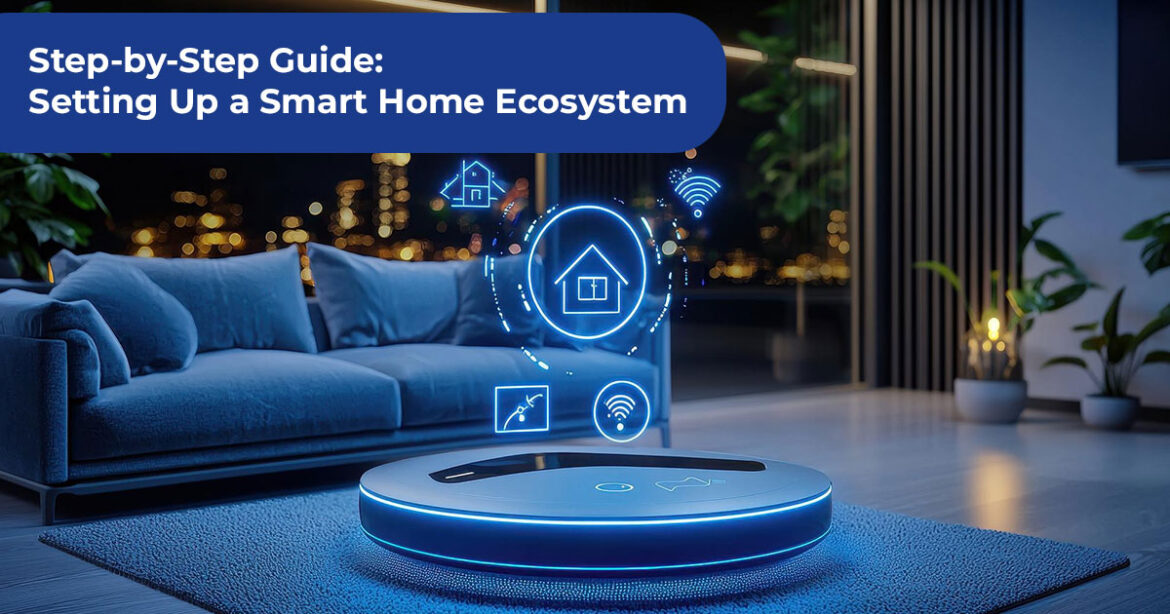Smart home technology has revolutionised modern living, transforming how people interact with their surroundings. From voice-controlled lighting and automated temperature control to AI-powered security systems that send real-time alerts, smart devices are bringing unmatched convenience, energy efficiency, and security to everyday life. What was once a futuristic luxury is now becoming a common reality in Australian homes, with more families adopting connected technologies each year.
However, as the number of smart home devices and brands grows, so does the complexity of setting up a truly integrated ecosystem. Homeowners often struggle with compatibility issues, inconsistent app experiences, and confusing network configurations. This is where having a structured approach makes all the difference.
In this guide, we’ll break down each step of creating a cohesive smart home ecosystem from initial planning and choosing the right platform to setting up your network, connecting devices, and maintaining performance over time. You’ll also learn how to future-proof your setup with scalable technologies that can evolve as your needs grow.
A well-designed smart home doesn’t just automate tasks it adapts to your lifestyle. Imagine your lights dimming automatically at sunset, your thermostat adjusting to your comfort preferences, and your door locking itself when you leave. With the right setup, your home becomes intuitive, responsive, and efficient, giving you more time to focus on what truly matters.
By the end of this guide, you’ll have a clear roadmap for building a connected home that balances innovation, reliability, and simplicity, ensuring every device works in harmony to create a smarter, safer, and more comfortable living environment.
1. Define Your Goals and Requirements
Before buying any devices, define what you want your smart home to achieve.
- Do you want to control lighting, heating, or security?
- Will voice control, app control, or automation suit your lifestyle best?
- What is your budget, and how quickly do you want to expand?
Creating a list of priorities helps avoid unnecessary purchases and ensures compatibility between devices. Also, take stock of any existing smart gadgets such as plugs, bulbs, or cameras that can be incorporated into your ecosystem.
2. Choose Your Core Ecosystem or Platform
Your chosen ecosystem determines how all your devices communicate. The most popular options are Amazon Alexa, Google Home, Apple HomeKit, and open-source solutions like Home Assistant. Increasingly, the Matter protocol ensures devices from different brands work together seamlessly.
| Platform | Strengths | Considerations |
| Amazon Alexa | Huge compatibility, strong voice control | Ad-supported interface, data privacy concerns |
| Google Home | Best for Android users, simple automation | Slightly fewer third-party integrations |
| Apple HomeKit | Excellent privacy, secure encryption | Limited compatible devices |
| Home Assistant | Fully local control, highly customisable | Requires technical know-how |
| Matter-Enabled | Cross-platform support and interoperability | Still rolling out across devices |
Select one main platform to avoid conflicts and simplify automation.
3. Build a Strong Home Network
A reliable network is the foundation of every home automation setup.
- Use a high-speed router with dual-band or tri-band connectivity.
- Install a mesh system to ensure stable Wi-Fi across large homes.
- Connect hubs and key devices via Ethernet to reduce latency.
- Separate IoT devices onto a guest network to improve security.
- Consider Zigbee, Z-Wave, or Thread for non-Wi-Fi connections that save bandwidth.
A solid network guarantees smooth communication between devices and prevents delays or disconnections.
4. Install a Smart Hub or Bridge
While many modern smart devices can operate directly over Wi-Fi, adding a smart hub or bridge creates a more reliable, efficient, and unified system. A hub acts as the central controller, allowing devices from different brands and communication protocols to work together seamlessly. It’s especially useful for managing multiple devices like smart lights, thermostats, and sensors without overloading your Wi-Fi network.
When choosing a hub, ensure it supports your chosen Smart Home Ecosystem and communication standards such as Zigbee, Z-Wave, or Thread. For instance, a Zigbee hub can connect several low-power devices such as motion sensors and smart bulbs while keeping your main network free from congestion.
Beyond connectivity, a hub enhances automation and response speed. It allows you to create complex, multi-device routines and continue controlling essential devices even when the internet connection temporarily drops.
5. Start with Core Device Categories
When beginning your smart devices integration, start with essentials before scaling up:
- Lighting – Smart bulbs, switches, and dimmers.
- Security – Cameras, locks, and motion sensors.
- Climate control – Smart thermostats and sensors.
- Appliances – Smart plugs, air purifiers, or vacuum cleaners.
- Entertainment – Smart TVs, speakers, and home assistants.
Install and test each category thoroughly before adding more. That way, you can confirm stability and avoid conflicting automations.
6. Integration and Automation
Automation transforms a set of devices into a truly smart home ecosystem.
- Assign clear names to each device for easier control.
- Create scenes like “Good Morning” or “Movie Time” for grouped actions.
- Add conditional logic — for instance, “Turn off lights when nobody is home.”
- Use geolocation so devices respond when residents arrive or leave.
- Integrate voice assistants to manage devices hands-free.
When done right, automation enhances convenience and energy efficiency while reflecting your daily routines.
7. Security and Privacy First
A connected home is convenient but vulnerable without proper safeguards. Strengthen IoT security in home with these measures:
- Use strong passwords and two-factor authentication.
- Keep firmware updated for all devices.
- Disable unused features such as remote access.
- Separate IoT devices on a different network.
- Monitor network traffic for suspicious activity.
Additionally, choose devices from reputable brands that prioritise encryption and regular updates.
8. Maintenance, Backup, and Troubleshooting
Smart systems need periodic checks to remain reliable.
- Back up configurations and automation rules.
- Review automations to remove duplicates or errors.
- Update firmware monthly for bug fixes.
- Reboot hubs periodically to prevent lag.
Common Troubleshooting
| Issue | Possible Cause | Solution |
| Device unreachable | Weak signal or power issue | Check power, reset, or re-pair device |
| Automation not triggering | Incorrect conditions | Review automation logic |
| Voice command unresponsive | Cloud delay or misnaming | Rename device or check hub connection |
Routine maintenance ensures that your system remains consistent and hassle-free.
9. Example Smart Home Architecture
A well-designed Smart Home Ecosystem architecture integrates multiple devices through a unified hub or platform for seamless communication. For instance, a central smart hub connects to Wi-Fi and manages smart lights, thermostats, security cameras, and voice assistants using protocols like Zigbee or Z-Wave. These devices then interact through automation rules for example, motion sensors triggering hallway lights or thermostats adjusting based on occupancy. Cloud services enable remote access and app control, while local processing ensures faster responses for essential tasks. This balanced setup delivers both reliability and flexibility, creating a truly intelligent home ecosystem
| Room / Zone | Devices | Protocols | Automation Example |
| Living Room | Smart plug, bulb, motion sensor, smart speaker | Zigbee, Wi-Fi | Turns on light with movement at night |
| Kitchen | Smart light, plug for coffee maker | Wi-Fi | Activates coffee maker at 7 a.m. |
| Entrance | Smart lock, video doorbell | Z-Wave, Wi-Fi | Auto-locks when leaving home |
| Bedroom | Smart bulbs, temperature sensors | Zigbee | Dims lights and cools room for sleep |
| Garden / Patio | Smart irrigation, outdoor light | Thread | Waters plants automatically at sunrise |
This structure maintains balance between comfort, convenience, and efficiency.
10. Advanced Tips and Best Practices
- Combine voice, app, and sensor control for redundancy.
- Use energy-monitoring plugs to track power usage.
- Group automations by room or theme.
- Create scenes for events like “Party Mode” or “Away Mode.”
- Enable alerts for door openings or smoke detection.
Smart home success lies in gradual expansion adding reliable devices, not rushing into a full overhaul.
11. The Future of Smart Home Automation
The best smart home setup 2025 will focus on simplicity, integration, and AI-driven intelligence. Key trends include:
- Broader Matter adoption for cross-brand compatibility.
- AI-powered automations that learn user habits.
- Stronger emphasis on local control and privacy.
- Integration with electric vehicles and renewable energy systems.
- Smarter voice assistants capable of natural conversation.
As technology evolves, smart homes will move from reactive to predictive understanding your needs before you even give a command.
Conclusion
Building a smart home ecosystem doesn’t have to be an overwhelming task. With the right planning, reliable networking, and careful integration, your home can evolve into a seamless environment of automation, comfort, and intelligence. The key is to start small perhaps with smart light bulbs, plugs, or door locks and then gradually expand your setup as you become more familiar with the technology.
Focus on security and regular updates to ensure your system remains protected and efficient. Stay open to new innovations, as the world of Smart Home Ecosystem technology continues to advance rapidly. Ultimately, a thoughtfully designed smart home doesn’t just simplify daily routines it redefines modern living, blending convenience, energy efficiency, and connectivity into one cohesive and truly smart lifestyle experience.

